Knee Replacement
The knee is a joint between the end of the thigh bone (the femur) and the top of the shin bone (the tibia). The knee cap (the patella) glides over the end of the femur when the knee moves. In a healthy joint, a layer of smooth hyaline or articular cartilage covers and cushions the bone ends. It is the presence of the cartilage, working together with muscles, tendons and ligaments, that allows a healthy knee to bend knee easily, without pain or discomfort.
Arthritis – particularly osteoarthritis, the “wear and tear” type of arthritis that is the most common form of arthritis – is a condition in which there is damage to this articular cartilage within the knee joint. Other types of arthritis that can affect the knee joint include rheumatoid arthritis, post-traumatic arthritis- in which a previous knee injury results in damage to the cartilage- and less common causes such as psoriatic arthritis and osteonecrosis. These conditions can all result in progressive damage to the cartilage, ultimately causing the bones to rub together (“bone-on-bone” arthritis) and leading to pain and stiffness.
Modern Total Knee Arthroplasty (TKA) or replacement surgery was introduced in 1974 by Drs. John Insall and Chit Ranawat in New York. Their introduction of the “total condylar knee” allowed the first accurate reconstruction of the knee joint. This total condylar knee was the first of its kind to address all aspects of the knee with an anatomically shaped design. Since 1974, the advances in the design of the modern knee replacement have been dramatic. With better implant materials and improved designs, implant longevity and patient outcomes have continued to improve.
In a total knee replacement surgery, the goal is to replace the damaged cartilage within the knee. The cartilage within the knee joint is replaced with a prosthesis made of metal and plastic. These artificial parts or implants allow the joint to move smoothly, so the patient experiences pain relief and a better quality of life. The total knee replacement surgery is typically performed in a hospital setting under general and/or spinal anesthesia. During the procedure, an incision is made over the knee to access the joint. Precise surgical technique is essential to achieve successful results for each individual surgery. Once the bones have been appropriately prepared, the prosthetic device is inserted, usually with polymethylmethacralate or bone cement to secure the prosthesis to the bone. Cemented knee replacements are the most commonly used, as they allow for immediate mobility and weight bearing on the knee. Recent advances in surgical technology make it possible to perform this procedure in the least invasive manner possible (see below). These techniques allow the joint to be replaced, while minimizing any trauma to the soft tissues (i.e. the muscles, tendons and ligaments) around the joint.
Knee replacement surgery, as the definitive treatment for knee arthritis, has become one of the most popular orthopaedic surgical procedures in the world. It is truly the only “cure” for knee arthritis.
Patient Photos
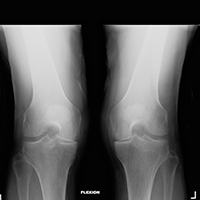
Patient 1 - Pre-operative Right Knee (Front View)
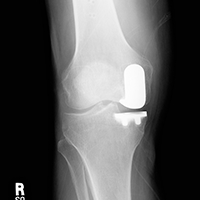
Patient 1 - Post-operative Right medial MAKOplasty Partial Knee (Front view)
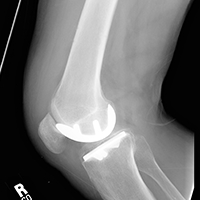
Patient 1 - Post-operative Right MAKOplasty Partial Knee (Lateral or side view)
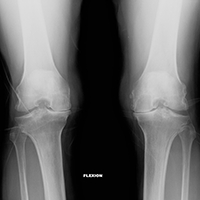
Patient 2 - Pre-operative Left Knee (Front View)
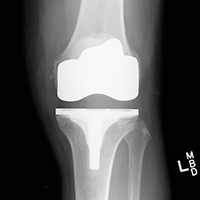
Patient 2 - Post-operative Left Total Knee Replacement (Front View )
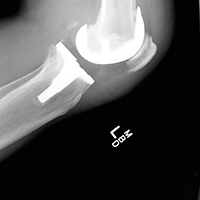
Patient 2 - Post-operative Left Total Knee Replacement (Lateral or side view)
Knee Arthritis Treatment Options
Advanced arthritis of the knee symptoms (pain, stiffness, limited motion, decreased walking and standing tolerance) can gradually worsen to the point where the arthritis interfers with day-to-day activities. For some patients, the symptoms from arthritis can eventually become so significant that they cannot walk or function without severe pain. For patients whose symptoms have reached this point, surgical intervention via joint replacement surgery can return patients to life style they used to enjoy- usually with minimal or no knee pain. It all comes down to your QUALITY OF LIFE!
Non-Operative Treatment Options for Knee Arthritis
As he does for many patients, Dr. Kaper can guide you through a conservative or non-operative plan to help treat your arthritis. The treatment options include: independent, low impact exercise; activity modification/rest; ice and/or heat; over-the-counter (OTC) medications;as well as weight loss, if appropriate. Additional non-operative treatments that Dr. Kaper can prescribe include: physical therapy; prescription anti inflammatory medications (NSAID’s)- like Celebrex or Mobic; Cortisone injections; Visco-supplementation injections, such as Supartz, Euflexxa, or Synvisc; arthritis unloader bracing, and, if indicated, for meniscal tears or loose bodies that can also cause significant knee pain – knee arthroscopy or a “scope” of the knee.
Total or Partial Knee Replacement
The knee joint itself is divided anatomically into three compartments- the medial compartment (inner half) ; the lateral compartment (lateral half); and the patello-femoral compartment (the patella or knee-cap). Total Knee Arthroplasty (TKA) or Replacement is recommended when there is significant damage to two or three of the knee compartments, causing disabling pain, deformity (varus – bow leg or valgus – knock knee) and/or limited knee motion. Partial or Uni-compartmental Knee replacement is typically recommended when just the medial or lateral compartment of the knee is damaged. A “Uni-Knee” can be performed with standard instrumentation or nowadays with a robotic-assisted technique using the NAVIO technique.
Total Knee Replacement Surgery
The technique of knee replacement has and continues to evolve, with changes and new techniques being introduced on a regular basis. Dr. Kaper has made significant adjustments and changes to the surgical process itself to improve both the early and long-term functional outcomes of knee replacement.
In the early 2000’s, there was a trend to try and perform total knee replacement surgery with “minimally invasive” techniques. After a decade of research, however, it is now clear that these “minimally invasive” procedures do not deliver on the promises of improved patient benefits. Studies have, unfortunately, report increased rates of complications with less reliable surgical outcomes. As a consequence, most of the orthopaedic surgery community now does not recommend the “minimally-invasive” approach for knee replacement.
In his ongoing effort to deliver the best surgical outcomes, Dr. Kaper has continued to seek other surgical technique improvements to benefit his patients. Efficient surgery, with minimized trauma to the tissues around the knee, allows Dr. Kaper to perform knee replacement surgery in the least invasive way possible- both physically and emotionally to the patient.
To achieve the desired result of a less-invasive knee replacement surgery, Dr Kaper follows a specific protocol, that starts prior to surgery and continues both during and after surgery. This protocol includes:
- Pre-operative physical therapy, also known as “prehab”, for a thorough conditioning program prior to surgery to help reduce joint stiffness and improve muscle function and strength before surgery;
- Pre-operative patient education, with a dedicated “team-approach” to surgery to ensure that the patient will have appropriate education and resources dedicated to them prior to and after surgery to maximize the outcomes of surgery;
- A “multi-modality” pain management approach with pre-emptive medication regimen;
- Minimal use of a tourniquet on the limb during surgery- usually about 45 minutes for most knee replacement surgeries;
- Meticulous handling of the tissues in and around the hip during surgery to minimize tissue inflammation;
- Careful control of any bleeding during surgery to minimize hematoma formation after surgery;
- Precise placement of the hip prosthesis, with careful attention to implant size, alignment, position and soft tissue balancing of the hip joint;
- Routine injection of longer-acting local anesthetic medications within the hip joint to minimize pain and bleeding after surgery;
- Routine use of medications that help control bleeding during and after surgery - medications known as anti-fibrinolytic agents, known as Tranexamic Acid or Amicar;
- Regular and aggressive use of “cryo-therapy” (a fancy way of saying icing) of the hip and thigh after surgery;
- Early post-operative mobilization with physical therapy to minimize stiffness of the hip joint and the muscles around the hip.
http://www.smith-nephew.com/patient/treatments/knee-treatments/knee-replacement/
Setting appropriate expectations for patients after surgery is also a focus of our conversations with patients. The importance of these types of conversations was recently highlighted in an article published in the Boston Globe:
Total Knee Prosthetics
There are many different knee replacement prostheses or implants available in the United States. Each manufacturer has their own individual "niche" which they will promote as being the best, latest or greatest. Dr, Kaper has used total knee implants manufactured by Smith & Nephew for over 15 years- specifically the Journey II total knee system. He receives no compensation or financial incentive of any sort from Smith & Nephew. He chooses to use their products because he has seen outstanding results with their prostheses. These implants are engineered to help optimize range of motion (ROM). These implants do offer “gender-specific” models which accommodate the subtle differences between the male and female knee anatomy. Smith & Nephew also offers the proprietary material known as "Oxinium". This material is an oxidized Zirconium implant, which allows the prosthesis to take on the excellent wear characteristics of ceramic, but importantly, without the risk of a fracture of the otherwise brittle alumina ceramics that are used by other implants manufacturers. Zirconium is a pure element (just as Titanium is). The advantage of using Zirconium is that it does not contain any other elements such as nickel. Approximately 5% of the population is allergic to nickel, even though they may not be aware of this fact. By using Zirconium for the knee replacement, concerns about potential allergies are minimized.
Smith & Nephew combines their Oxinium product with a highly cross-linked polyethylene (XLPE) plastic technology in what they call the ”Verilast knee” (http://www.rediscoveryourgo.com/Product.aspx?Product=VERILAST). In the research labs, this Verilast Knee Replacement system has shown the ability to minimize wear and maximize longevity. This translates to the possibility that this knee replacement system may last up to 30 years- a very exciting prospect for our patients.
For the revision or "re-do" knee replacements, which Dr. Kaper performs frequently, he also uses Smith & Nephew products, specifically the Legion implant system. This implant has many technical advantages for all different knee variations, including “complex options” with stems and wedges and revision components. The Legion system is from the Genesis II family of proven performance implants. By virtue of the unique implant design features and materials the Legion Total Knee System is ideally suited to address the sometimes challenging nature of knee revision surgery. This implant is also available in the Oxinium material described above.
Risks Associated with Total Knee Replacement
As with any surgical procedure, there are real risks associated with knee replacement surgery. Although knee replacement is a common procedure today, it is still a major surgical procedure. Risks include: infection; stiffness of the knee; blood clots (deep vein thrombosis or DVT and pulmonary embolism or PE); fracture around the knee prosthesis; injury to a nerve around the knee which could result in temporary or permanent loss of nerve function; injury to blood vessels around the knee; persistent pain in the knee; loosening of the knee prosthesis; medical complications, such as stroke or heart attack; and the potential need for further surgery. As the saying goes, there are no guarantees in life. Complications can and do happen. If a complication were to occur, Dr. Kaper will explain the situation is detail and offer appropriate treatment to address the complication.
Patients will often inquire about the possibility of having both knees replaced at the same time- also known as "Simultaneous Bilateral TKA" surgery. Dr. Kaper does perform bilateral total knee replacements, but it is important to recognize that the most recent studies show a statistically higher risk with such a surgery, including a 2.5 fold increase risk of heart attack; and a 2-fold increase risk of blood clot and even death. Consequently, consideration to perform a bilateral simultaneous total knee replacement surgery must take into account these risks. A final decision is always made between Dr. Kaper and the patient to determine the safest approach.
The younger the patient is at the time of knee replacement surgery, the higher the chance that further surgery may be necessary at some time in the future. Most knee replacement prostheses or implants are designed to tolerate everyday activities for many years. Most long-term studies are showing >90% of knee implants are still functioning well after 15 years. With the ongoing improvement in the prosthetic materials used for knee replacement, it may be that we can look forward to 20-30 years of use from a knee replacement. Please recognize, however, that there truly can be no guarantees in this regard. Dr. Kaper will be happy to discuss the different options, choices and recommendations that he will make in regard to your knee replacement prosthesis.
If you have questions about knee replacement surgery, please call the office at (480)305-0034 to schedule a consultation.
Pre-operative Medical Evaluation
Prior to any surgical procedure, a medical evaluation is recommended. This evaluation is usually performed by a patient’s primary care physician, arranged in conjunction with our office. Evaluation will include a physical examination, EKG and basic laboratory tests. This type of evaluation will allow us to establish a good picture of a patient’s baseline medical health - and allow us to recommend specific areas that could be optimized prior to surgery.
Occasionally, medical concerns are identified that need attention and treatment prior to surgery. Patients with diabetes are of particular concern. There is substantial research to suggest that diabetic patients are at increased risk for complications. This increased risk can be reduced if the patient is compliant with their blood sugar control. The test of the Hemoglobin A1C (Hbg A1C) is the most reliable test to check on long term blood sugar control. The HgbA1C should be at or below 7 before any elective surgery. If the lab test is greater than 7, it is usually best to postpone surgery to allow the patient to get their sugars under between control. It is certainly not prudent to proceed knowing the risk of complications is higher than necessary.
Obesity is another medical challenge for some patients. Obesity is defined based on a patients’ “Body Mass Index” or BMI for short. A BMI over 40 increases the risk for infection after joint replacement surgery. If a patient is unsuccessful, through a combination of diet and exercise, at losing weight to get their BMI below 40, bariatic surgery may need to be considered.
Patients with underlying lung, heart, kidney or liver problems may need consultation with a specialist in one or more of these areas prior to surgery. Further testing may be needed depending on a patient’s individual circumstance.
Tobacco use is another cause of concern. Smoking have been shown to increase the risk of complications after many orthopaedic surgeries, including joint replacement and spinal surgery. The best advice is for the patient to stop smoking. Help from your primary care physician can be obtained to assist in this goal.
Our goal is to minimize the risks associated with surgery - this includes reducing the medical risks that our patients may be exposed to.
The Economics of Knee Replacement Surgery
More and more patients are getting involved with the economic side of medicine- as we believe they should since the patient is the ultimate consumer of the healthcare product. Our office strives to be as transparent as possible with regard the cost of any surgical procedures. Surgical procedures are billed through the use of a nationally established set of codes, known as the Common Procedural Terminology or CPT for short.
Total Knee Arthroplasty (TKA) is billed as CPT code 27447; Partial Knee Arthroplasty (Uni-knee) is CPT code 27446; Partial Revision of TKA (one component- either femoral or tibial) is CPT 27486; Complete Revision of TKA (both components- femoral and tibial) is CPT 27487. Although this information can be confusing, knowledge of these codes is helpful to patients in order to understand the foundation from which surgical billing is determined. Surgeon fees will vary. Often the reimbursed amount is determined by the contract between the surgeon and your insurance company. In addition to the surgeons' fee, additional charges will be incurred in the entire surgical process. These include surgical assistant fee, anesthesiologist fee, hospital fee and physical therapy fee. If you would like to know more or have specific questions about medical costs, please do not hesitate to contact my office billing and insurance specialist.
Guidelines for Prophylactic Antibiotics after Knee Replacement
For most patients, pre-procedure antibiotic prophylaxis is not necessary.
For patients dealing with immuno-suppression, conditions like diabetes, cancer diagnosis and/or treatment, or use of medications that suppress the body's immune system, routine dental prophylaxis is recommended. This typically is one dose of Keflex or Amoxicillin, 2 grams orally, taken one hour prior to dental work For patients with allergies to Penicillins, we recommend Clindamycin 600 mg orally.
Similar protocols are recommended for any invasive procedure that you may need after your joint replacement surgery.



